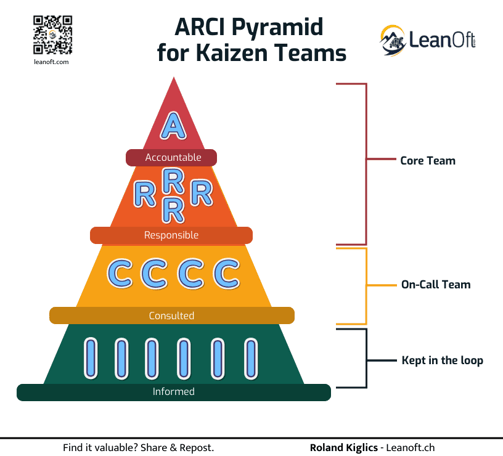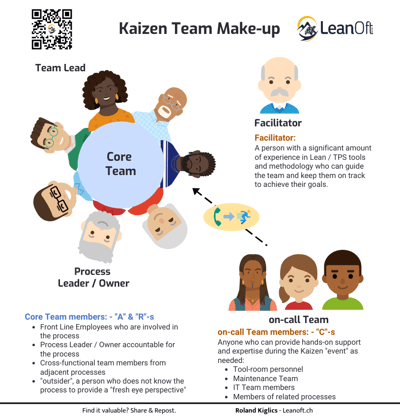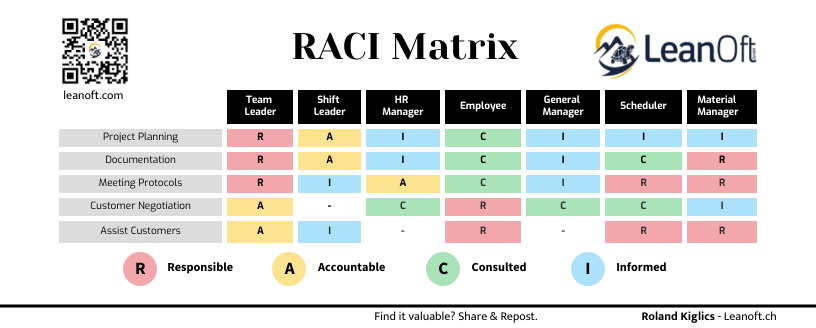Using RACI and ARCI matrixes for effective Kaizen "events".
Explore how to use the RACI matrix to support your Kaizen activities.
CONTINUOUS IMPROVEMENTKAIZENLEAN MANAGEMENT FOR STARTUPS AND SMESLEAN MANAGEMENT CONSULTING
Roland Kiglics
10/14/20244 min read
Introduction
In my previous article titled "How to prepare for a Kaizen week or "event"", I briefly mentioned the use of a RACI matrix as a good practice during preparation.
Now I would like to provide more detailed information on why and how the RACI matrix can be used effectively in Kaizen "events".
What is a RACI Matrix?
In business and project management, a Responsibility Assignment Matrix, also known as a RACI Matrix, describes the involvement of different roles in the completion of tasks or deliverables for a project or business process. RACI stands for "Responsible, Accountable, Consulted, and Informed. [1]
When used correctly, it helps to avoid the frustrating moment when someone with a "bigger job title" comes along at the end of a project and says "I didn't know about that", leaving everyone involved in the project feeling completely blindsided. A well-structured matrix clearly identifies roles and responsibilities for each task or business process.
Understanding RACI Roles
Let’s break down what each letter in RACI means:
Responsible: Those working, who are actually completing the task.
Accountable: The person with decision-making authority.
Consulted: Subject matter experts whose knowledge is sought; they are usually external to the core process.
Informed: Those who need to be kept in the loop to ensure smooth adoption.
RACI vs. ARCI
I personally prefer to use ARCI instead of RACI because it highlights an important aspect of how to use this matrix. Think of ARCI as a pyramid: at the top is a single accountable individual, while the roles below represent those with more representatives.
You might ask yourself: "In a true Kaizen organization, aren't those closest to the work deciding what to improve?" Yes, and while front-line input is essential for identifying improvements, there must be accountability at higher levels to ensure that decisions are manifested both financially and physically.


Best practice in a true Kaizen organization is to assign responsibility during the event to someone with the lowest possible rank in the team - for example, a machine operator in a shop rather than the shift supervisor, or a medical assistant in a hospital rather than the head nurse. This approach promotes team building and increases commitment.
Think of it as two layers of accountability: business leadership identifies what needs to be improved based on existing problems or hoshin kanri plans. Once that's established, accountability for implementing those improvements is delegated downwards. The person who is accountable may also be responsible for getting the job done.
In addition, decisions are often made collectively by the team during a Kaizen "event". The accountability role serves as a final decision maker when consensus cannot be reached. This concept is in keeping with the idea of "one kitchen, one cook", ensuring that while many contribute ideas and effort, there is clarity in decision-making authority.
Roles in Kaizen Teams
It's important to have at least one person responsible for carrying out the tasks; however, more people may be needed if the scope is complex. A typical Kaizen team consists of 6-8 people responsible for implementing improvements.
For the Consulted and Informed roles, you can assign multiple people depending on the scope. Those identified as consulted are 'on call' during preparation and throughout the event. Occasionally they may become active participants - such as electricians disconnecting equipment that needs to be moved - but they are not part of the core team responsible for implementing improvements.


How RACI Helps During Kaizen
During a Kaizen event, teams review current processes and identify improvement opportunities. Key questions include:
Do we need so many “R”s? Can fewer people do the job? It's not about reducing staff, it's about creating efficiencies so that resources can be focused on critical tasks.
Are there too many “C”s? Excessive consulted roles can lead to communication overload with little actionable output.
Are there too many “I”s? Too many individuals wanting updates can create bureaucratic bottlenecks and distract from actual work. It becomes a reporting nightmare.
Take your time to find the right balance. The kaizen approach of trial and error to refine your approach will help over time.
Benefits & Downside of using RACI Matrix for Kaizen "events"
Clearly defines responsibilities for each team member.
Enhances visibility regarding who is ultimately answerable for tasks.
Ensures that everyone who needs to be informed stays updated.
Minimizes unnecessary meetings and communication overhead.
Serves as a reference point for resolving disputes and clarifying roles.
Benefits of Using a RACI Matrix
Downsides of Using a RACI Matrix
Waste of Time, creating a RACI matrix for every Kaizen “event” can be unnecessary if the scope is simple; it may lead to inefficiencies rather than improvements.
Can lead to confusion if roles aren't clearly understood.
May reinforce rigid structures that hinder collaboration.
Can become complex with numerous tasks and team members in large projects.
Without real-time updates, it may quickly become outdated.
Misunderstandings can arise regarding Accountability versus Responsibility. The difference between 'accountable' and 'responsible' is not always clear to everyone.
For simpler Kaizen “events” where processes are easy to understand, creating a RACI matrix may be unnecessary—so don’t do it! However, for complex transformational initiatives involving multiple organizations and cross-functional teams, developing a RACI matrix becomes critical for clarity and effective decision-making.
Conclusion
Involve all stakeholders in reviewing the RACI matrix to ensure that roles are accurately defined and understood. This collaborative effort will prevent misunderstandings in the decision-making processes.
As you prepare for your next Kaizen “event”, consider how a well-structured RACI matrix can improve clarity and collaboration within your team!
Reference
“Responsibility assignment matrix“ -Wikipedia, 7. May 2024
Book Your First Consultation
Get in touch to discuss how LeanOft can help you today.
Get to know us
Do you prefer personal contact over a form? Take the opportunity and write an email to get to know LeanOft and the people behind it.
Quick and Direct Access
Give us a call:
+41779456508
LeanOft GmbH provides hands-on, People-Centered Lean implementation support and problem solving for organizations that want to be better tomorrow than they are today.
LeanOft GmbH is primarily based in Switzerland and is working with companies in Switzerland and in Europe
Follow us
COPYRIGHT © 2025 LeanOft GmbH


+41779456508


